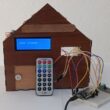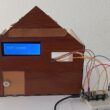The water level sensor

Definition of the water level sensor
A water level sensor is a device used to detect and measure the level of water in a tank, reservoir, or any other container. There are various types of water level sensors available, including contact and non-contact sensors, and they can be used in a wide range of applications, such as irrigation systems, water tanks, and industrial processes.
Contact water level sensors typically use a probe or a series of probes to measure the level of water. When the water level rises or falls, the probes make contact with or lose contact with the water, which triggers a signal that is sent to a controller or a monitoring system. Contact sensors can be made of various materials, such as stainless steel, plastic, or ceramics, depending on the application.
Non-contact water level sensors use different technologies to detect the water level without making physical contact with the water. For example, ultrasonic sensors emit high-frequency sound waves that bounce off the surface of the water and are then detected by the sensor. The time it takes for the sound waves to return to the sensor is used to calculate the distance between the sensor and the water level, and hence the water level itself.
Water level sensors are commonly used in automatic irrigation systems to monitor the water level in a reservoir and ensure that plants receive the right amount of water. They are also used in industrial processes to monitor the level of liquids in tanks and prevent overfilling or spills. In addition, water level sensors are used in environmental monitoring systems to measure the water level in rivers, lakes, and other bodies of water, which can be useful for flood warning systems and water management.
Types of water level sensor
There are several types of water level sensors available, each with its own advantages and disadvantages. Here are some of the most common types:
Float-based sensors: These sensors use a float that moves up and down with the water level, and the position of the float is used to determine the water level. These sensors are simple and reliable, but they can be prone to getting stuck or fouled with debris.
Conductive sensors: These sensors use probes that are immersed in the water, and when the water level reaches a certain height, the probes make contact with each other and complete an electrical circuit. These sensors are inexpensive and easy to use, but they can be prone to false readings due to mineral buildup or other factors.
Capacitive sensors: These sensors use electrodes to measure the capacitance of the water, which changes as the water level rises and falls. These sensors are accurate and reliable, but they can be more expensive than other types.
Ultrasonic sensors: These sensors use high-frequency sound waves to measure the distance to the water surface, which is then used to calculate the water level. Ultrasonic sensors are non-contact and can be very accurate, but they can be affected by obstacles or turbulence in the water.
Pressure sensors: These sensors measure the pressure of the water at a certain depth, which can be used to calculate the water level. Pressure sensors are accurate and reliable, but they can be more expensive and complex to install than other types.
The type of water level sensor that is best for a particular application depends on factors such as the accuracy required, the environment in which the sensor will be used, and the budget available
Float water level sensor pins

The pins of a float water level sensor can vary depending on the specific model and manufacturer, but most float sensors have two or three pins.
The two-pin float sensors typically have one pin for power (+) and one pin for signal output (S). The signal output pin sends a signal to the microcontroller or monitoring system when the float reaches a certain height in the water tank or reservoir.
Three-pin float sensors have an additional pin for ground (-) to complete the electrical circuit. The power pin (+) provides voltage to the sensor, the signal output pin (S) sends a signal to the microcontroller or monitoring system, and the ground pin (-) completes the circuit.
Water level sensor compatible microcontrollers
Water level sensors can be used with a variety of microcontrollers, including:
Arduino: Arduino boards are popular among hobbyists and professionals alike, and there are many libraries and examples available for interfacing with water level sensors.
Raspberry Pi: The Raspberry Pi is a single-board computer that can be used for a wide range of applications, including water level monitoring.
ESP32: The ESP32 is a powerful microcontroller that is compatible with many sensors and can connect to Wi-Fi and Bluetooth.
STM32: The STM32 microcontroller is popular for industrial and commercial applications and can handle multiple sensors and interfaces.
PIC microcontrollers: PIC microcontrollers are commonly used in embedded systems and can be programmed using various programming languages.
Programming the Float Water Level Sensor
Here is an example code for programming a float water level sensor with an Arduino:
|
1 2 3 4 5 6 7 8 9 10 11 12 13 14 15 16 17 18 19 20 21 |
// Define the pins for the float sensor const int sensorPin = 2; void setup() { // Initialize the serial communication for debugging Serial.begin(9600); // Set the sensor pin as an input pinMode(sensorPin, INPUT); } void loop() { // Read the sensor value int sensorValue = digitalRead(sensorPin); // Print the sensor value for debugging Serial.println(sensorValue); // Wait for a short period before reading the sensor again delay(100); } |
In this example code, we define the pin for the float sensor as const int sensorPin = 2;. We then set up the setup() function to initialize the serial communication for debugging and set the sensor pin as an input with pinMode(sensorPin, INPUT);.
In the loop() function, we read the sensor value using int sensorValue = digitalRead(sensorPin);. We then print the sensor value to the serial monitor for debugging with Serial.println(sensorValue);.
Finally, we add a short delay with delay(100); before reading the sensor value again. This delay helps to ensure that we don't overwhelm the microcontroller with too many readings at once.
This is a simple example code, and there are many ways to program a float water level sensor with an Arduino or other microcontroller depending on the specific requirements of the project. The code can be modified to include additional features such as sending alerts or logging data to an SD card or cloud service.
Role of the water level sensor in robotics
Water level sensors can play an important role in robotics, particularly in applications that involve water or other liquids. Some examples of the role of water level sensors in robotics include:
Water level monitoring: In aquatic robots or underwater vehicles, water level sensors can be used to monitor the water level and ensure that the robot is at the correct depth.
Liquid level monitoring: In applications that involve liquids other than water, such as chemical processes, water level sensors can be used to monitor the level of the liquid and ensure that it stays within a certain range.
Leak detection: Water level sensors can also be used to detect leaks in systems that involve liquids. By monitoring the water level in a tank or reservoir, the sensor can alert the robot to any drops in water level that may indicate a leak.
Navigation: In some cases, water level sensors can be used to help a robot navigate through water or other liquids. By using the water level sensor to detect the surface of the liquid, the robot can maintain a stable position and move through the liquid more efficiently.
Role of water level sensor in smart Irrigation Systems
Water level sensors are an important component of smart irrigation systems as they help to monitor and control water levels in irrigation tanks or reservoirs. Here are some of the key roles of water level sensors in smart irrigation systems:
Water Management: Water level sensors help to manage the water supply in irrigation systems by measuring the water level in tanks or reservoirs. This information is then used to control the flow of water into the system and ensure that there is always enough water available for irrigation.
Water Conservation: By monitoring water levels in real-time, water level sensors can help to prevent overflows and reduce water waste. This ensures that water is used efficiently, and reduces the risk of water shortages.
Efficiency: Water level sensors can be integrated into automated irrigation systems, allowing for precise control over water flow and timing. This ensures that water is applied only when and where it is needed, reducing the risk of overwatering and saving water.
Cost Savings: By optimizing water use and reducing water waste, smart irrigation systems with water level sensors can help to save money on water bills and irrigation system maintenance.























